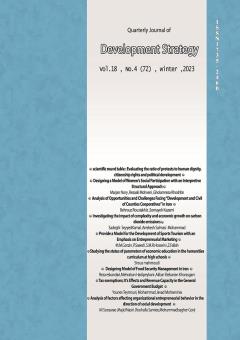-
-
List of Articles
-
Open Access Article
1 - Designing a Model of Women's Social Participation with an Interpretive Structural Approach
رضاعلی محسنی Gholamreza Khoshfar مرجان نوری -
Open Access Article
2 - Analysis of Opportunities and Challenges Facing “Development and Civil of Counties Cooperatives” in Iran
Behrouz Roustakhiz Soamye Kazemi -
Open Access Article
3 - Investigating the impact of complexity and economic growth on carbon dioxide emissions
seyedkamal sadeghi Mohammad Arrekesh Salmasi -
Open Access Article
4 - Provide a Model for the Development of Sports Tourism with an Emphasis on Entrepreneurial Marketing
Mohammad mahdi Gorzin پرویز سعیدی zeinolabedin fallah -
Open Access Article
5 - Studying the status of parameters of economic education in the humanities curriculum at high schools
سیروس محمودی -
Open Access Article
6 - Designing Model of Food Security Management in Iran
Reza Eskandari Mehraban Hadi Peykani akbar etebarian -
Open Access Article
7 - Tax exemptions; It’s Effects and Revenue Capacity in the General Government Budget
Younes Teymouri محمدجواد محسنینیا -
Open Access Article
8 - Analysis of factors affecting organizational entrepreneurial behavior in the direction of social development
ali soosarae majid nasiri Roohalla samiee محمدباقر گرجی
-
The rights to this website are owned by the Raimag Press Management System.
Copyright © 2017-2026







